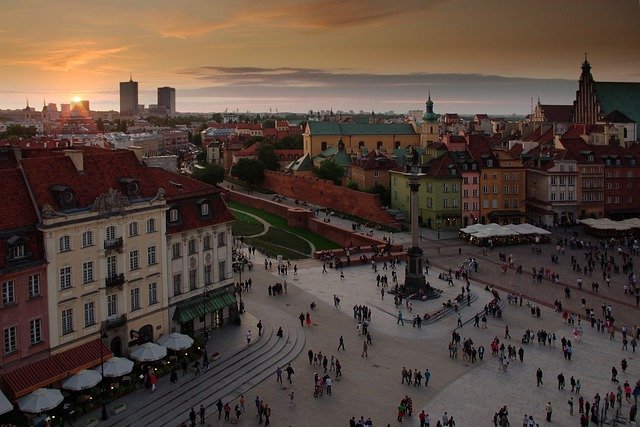By Tim Lambert
Dedicated to Karina Smulska
Early Warsaw
Warsaw developed later than other Polish towns. By the 10th century, there was a small settlement on the River Wisla. However, it didn’t grow into a town until the 14th century. In 1413 Warsaw became the capital of the Duchy of Mazovia. Then in 1526, Mazovia became an integral part of the kingdom of Poland. Warsaw Barbican was built in 1548. Then in 1569, Poland united with Lithuania and the Sejm (parliament) voted to meet in Warsaw.
Then in 1596, Warsaw was made the capital of Poland making it far more important. King Sigismund’s Column was erected in 1644. Warsaw suffered in the war with Sweden in 1655-1660. However, Wilanow Palace was built at the end of the 17th century and the 18th century was a great age for the city.
The population of Warsaw rose and architecture flourished. Saxon Gardens were laid out in the early 18th century. The National Theater was founded in 1765.
However, in 1795 Warsaw was taken by Prussia. In 1806 Napoleon made Warsaw the capital of the Duchy of Warsaw. But in 1815 the Congress of Vienna handed Warsaw to Russia.
Modern Warsaw
In the 19th century, Warsaw gradually developed. Warsaw University was founded in 1816. The Nicolaus Copernicus Monument was unveiled in 1830. In 1848 a railway opened to Vienna. The Warsaw Mermaid statue was made in 1855. The population of Warsaw also rose rapidly. Warsaw gained sewers and a piped water supply. It also gained gaslight. From 1904 it had electricity. After 1908 electric trams ran in the streets of Warsaw.
Meanwhile, Marie Curie was born Marya Sklodowska in Warsaw on 7 November 1867.
In 1915 during the First World War, the Germans captured Warsaw. But in 1918 Poland became an independent nation again and Warsaw was made its capital. In 1920 the Battle of Warsaw was fought between the Poles and the Communist Russians east of the city. Also in 1920, the Polish Army Museum was founded. Afterward, Warsaw continued to flourish.
However, in September 1939, the Germans invaded Poland. They began bombing Warsaw and captured it on 27 September. At that time about 1/3 of the population of Warsaw were Jews (about 380,000 people). From October 1940 the Germans herded Jews from Warsaw and the surrounding area into a ghetto. In 1942 the Germans began deporting Jews from the ghetto to concentration camps. In April 1943 the remaining Jews in the ghetto rose in rebellion. They fought bravely but the Germans were much better armed and inevitably the uprising was crushed.
Later, on 1 August 1944, the people of Warsaw rose in rebellion. It was courageous but the Nazis rushed in reinforcements and they gradually retook the city, with their usual brutality. The Poles finally surrendered on 2 October 1944. Meanwhile, Stalin stood by and did nothing. However, on 17 September 1945, the Russians captured Warsaw.
At the end of the Second World War Warsaw was left devastated. Most of its buildings were destroyed. However, it was slowly rebuilt. n The Palace of Culture and Science was built in 1955. The Museum of Marie Curie was founded in 1967. The Warsaw Uprising Monument was unveiled in 1989. The Museum of Independence was founded in 1990. Warsaw Metro opened in 1995. Warsaw Financial Center was built in 1998. The Warsaw Rising Museum opened in 2004.

Today Warsaw is a flourishing and vibrant city. In 2024 the population of Warsaw was 1.8 million.
Last revised 2024